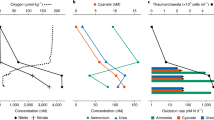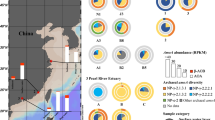Abstract
Ammonia oxidation in marine and terrestrial ecosystems plays a pivotal role in the cycling of nitrogen and carbon. Recent discoveries have shown that ammonia-oxidizing archaea (AOA) are both abundant and diverse in these systems, yet very little is known about their physiology. Here we report a physiological analysis of a novel low-salinity-type AOA enriched from the San Francisco Bay estuary, Candidatus Nitrosoarchaeum limnia strain SFB1. N. limnia has a slower growth rate than Nitrosopumilus maritimus and Nitrososphaera viennensis EN76, the only pure AOA isolates described to date, but the growth rate is comparable to the growth of marine AOA enrichment cultures. The growth rate only slightly decreased when N. limnia was grown under lower-oxygen conditions (5.5 % oxygen in the headspace). Although N. limnia was capable of growth at 75 % of seawater salinity, there was a longer lag time, incomplete oxidation of ammonia to nitrite, and slower overall growth rate. Allylthiourea (ATU) only partially inhibited growth and ammonia oxidation by N. limnia at concentrations known to completely inhibit bacterial ammonia oxidation. Using electron microscopy, we confirmed the presence of flagella as suggested by various flagellar biosynthesis genes in the N. limnia genome. We demonstrate that N. limnia is representative of a low-salinity estuarine AOA ecotype and that more than 85 % of its proteins have highest identity to other coastal and estuarine metagenomic sequences. Our findings further highlight the physiology of N. limnia and help explain its ecological adaptation to low-salinity niches.






Similar content being viewed by others
References
Schleper C, Nicol G (2010) Ammonia-oxidising archaea—physiology, ecology and evolution. Adv Microb Physiol 57:1–41
Erguder TH, Boon N, Wittebolle L, Marzorati M, Verstraete W (2009) Environmental factors shaping the ecological niches of ammonia-oxidizing archaea. FEMS Microbiol Rev 33:855–869. doi:10.1111/j.1574-6976.2009.00179.x
Schleper C (2010) Ammonia oxidation: different niches for bacteria and archaea? ISME J 4:1092–1094. doi:10.1038/ismej.2010.111
Martens-Habbena W, Berube PM, Urakawa H, La Torre De JR, Stahl DA (2009) Ammonia oxidation kinetics determine niche separation of nitrifying archaea and bacteria. Nature 461:976–979. doi:10.1038/nature08465
Blainey PC, Mosier AC, Potanina A, Francis CA, Quake SR (2011) Genome of a low-salinity ammonia-oxidizing archaeon determined by single-cell and metagenomic analysis. PLoS One 6:e16626
Mosier A (2011) Microbial nitrogen cycling dynamics in coastal systems. Dissertation, Stanford University, Stanford
Stahl D, Amann R, Stackebrandt E, Goodfellow M (1991) Development and application of nucleic acid probes. In: Nucleic acid techniques in bacterial systematics. Wiley, Chichester
Amann RI, Zarda B, Stahl DA, Schleifer KH (1992) Identification of individual prokaryotic cells by using enzyme-labeled, rRNA-targeted oligonucleotide probes. Appl Environ Microbiol 58:3007–3011
Daims H, Brühl A, Amann R, Schleifer KH, Wagner M (1999) The domain-specific probe EUB338 is insufficient for the detection of all bacteria: development and evaluation of a more comprehensive probe set. Syst Appl Microbiol 22:434–444
Hunt DE et al (2008) Resource partitioning and sympatric differentiation among closely related bacterioplankton. Science 320:1081–1085. doi:10.1126/science.1157890
Mosier A, Francis C (2008) Relative abundance and diversity of ammonia-oxidizing archaea and bacteria in the San Francisco Bay estuary. Environ Microbiol 10:3002–3016. doi:10.1111/j.1462-2920.2008.01764.x
Seshadri R, Kravitz SA, Smarr L, Gilna P, Frazier M (2007) CAMERA: a community resource for metagenomics. PLoS Biol 5:e75. doi:10.1371/journal.pbio.0050075
Lehtovirta-Morley LE, Stoecker K, Vilcinskas A, Prosser JI, Nicol GW (2011) Cultivation of an obligate acidophilic ammonia oxidizer from a nitrifying acid soil. Proc Natl Acad Sci USA. doi:10.1073/pnas.1107196108
Santoro AE, Casciotti KL (2011) Enrichment and characterization of ammonia-oxidizing archaea from the open ocean: phylogeny, physiology and stable isotope fractionation. ISME J 5:1796–1808. doi:10.1038/ismej.2011.58
de la Torre J, Walker C, Ingalls A, Könneke M, Stahl D (2008) Cultivation of a thermophilic ammonia oxidizing archaeon synthesizing crenarchaeol. Environ Microbiol 10:810–818. doi:10.1111/j.1462-2920.2007.01506.x
Park B-J et al (2010) Cultivation of autotrophic ammonia-oxidizing archaea from marine sediments in coculture with sulfur-oxidizing bacteria. Appl Environ Microbiol 76:7575–7587. doi:10.1128/AEM.01478-10
Tourna M et al (2011) Nitrososphaera viennensis, an ammonia oxidizing archaeon from soil. Proc Natl Acad Sci 108:8420–8425. doi:10.1073/pnas.1013488108
Loescher CR et al (2012) Production of oceanic nitrous oxide by ammonia-oxidizing archaea. Biogeosci Discuss 9:2095–2122. doi:10.5194/bgd-9-2095-2012
Hatzenpichler R et al (2008) A moderately thermophilic ammonia-oxidizing crenarchaeote from a hot spring. Proc Natl Acad Sci 105:2134–2139. doi:10.1073/pnas.0708857105
Santoro AE, Casciotti KL, Francis CA (2010) Activity, abundance and diversity of nitrifying archaea and bacteria in the central California Current. Environ Microbiol 12:1989–2006. doi:10.1111/j.1462-2920.2010.02205.x
Hooper AB, Terry KR (1973) Specific inhibitors of ammonia oxidation in Nitrosomonas. J Bacteriol 115:480–485
Ginestet P, Audic J, Urbain V, Block J (1998) Estimation of nitrifying bacterial activities by measuring oxygen uptake in the presence of the metabolic inhibitors allylthiourea and azide. Appl Environ Microbiol 64:2266–2268
Ravishankara AR, Daniel JS, Portmann RW (2009) Nitrous oxide (N2O): the dominant ozone-depleting substance emitted in the 21st century. Science 326:123–125. doi:10.1126/science.1176985
Codispoti LA (2010) Oceans. Interesting times for marine N2O. Science 327:1339–1340. doi:10.1126/science.1184945
Braker G, Conrad R (2011) Diversity, structure, and size of N2O-producing microbial communities in soils—what matters for their functioning? Adv Appl Microbiol 75:33–70. doi:10.1016/B978-0-12-387046-9.00002-5
Arp DJ, Stein LY (2003) Metabolism of inorganic N compounds by ammonia-oxidizing bacteria. Crit Rev Biochem Mol Biol 38:471–495. doi:10.1080/10409230390267446
Cantera J, Stein L (2007) Molecular diversity of nitrite reductase genes (nirK) in nitrifying bacteria. Environ Microbiol 9:765–776
Treusch A et al (2005) Novel genes for nitrite reductase and Amo-related proteins indicate a role of uncultivated mesophilic crenarchaeota in nitrogen cycling. Environ Microbiol 7:1985–1995
Yooseph S et al (2007) The Sorcerer II Global Ocean Sampling expedition: expanding the universe of protein families. PLoS Biol 5:e16. doi:10.1371/journal.pbio.0050016
Bartossek R, Nicol GW, Lanzen A, Klenk H-P, Schleper C (2010) Homologues of nitrite reductases in ammonia-oxidizing archaea: diversity and genomic context. Environ Microbiol 12:1075–1088. doi:10.1111/j.1462-2920.2010.02153.x
Walker CB et al (2010) Nitrosopumilus maritimus genome reveals unique mechanisms for nitrification and autotrophy in globally distributed marine crenarchaea. Proc Natl Acad Sci USA 107:8818–8823. doi:10.1073/pnas.0913533107
Lund, M. B., Smith, J. M., & Francis, C. A. (2012). Diversity, abundance and expression of nitrite reductase (nirK)-like genes in marine thaumarchaea. The ISME Journal. doi:10.1038/ismej.2012.40
Santoro AE, Buchwald C, Mcilvin MR, Casciotti KL (2011) Isotopic signature of N2O produced by marine ammonia-oxidizing archaea. Science 333:1282–1285
Dundee L, Hopkins D (2001) Different sensitivities to oxygen of nitrous oxide production by Nitrosomonas europaea and Nitrosolobus multiformis. Soil Biol Biochem 33:1563–1565
Cantera J, Stein L (2007) Role of nitrite reductase in the ammonia-oxidizing pathway of Nitrosomonas europaea. Arch Microbiol 188:349–354
Hollibaugh JT, Gifford S, Sharma S, Bano N, Moran MA (2011) Metatranscriptomic analysis of ammonia-oxidizing organisms in an estuarine bacterioplankton assemblage. ISME J 5:866–878. doi:10.1038/ismej.2010.172
Hunter S et al (2009) InterPro: the integrative protein signature database. Nucleic Acids Res 37:D211–5. doi:10.1093/nar/gkn785
Könneke M et al (2005) Isolation of an autotrophic ammonia-oxidizing marine archaeon. Nature 437:543–546
Wanner BL (1993) Gene regulation by phosphate in enteric bacteria. J Cell Biochem 51:47–54. doi:10.1002/jcb.240510110
Oganesyan V et al (2005) Crystal structure of the “PhoU-like” phosphate uptake regulator from Aquifex aeolicus. J Bacteriol 187:4238
Gebhard S, Ekanayaka N, Cook GM (2009) The low-affinity phosphate transporter PitA is dispensable for in vitro growth of Mycobacterium smegmatis. BMC Microbiol 9:254. doi:10.1186/1471-2180-9-254
Wankel S, Kendall C, Francis C, Paytan A (2006) Nitrogen sources and cycling in the San Francisco Bay estuary: a nitrate dual isotopic composition approach. Limnol Oceanogr 51:1654–1664
Peterson D et al (1985) Interannual variability in dissolved inorganic nutrients in Northern San Francisco Bay estuary. Hydrobiologia 129:37–58
Jassby A (2008) Phytoplankton in the Upper San Francisco estuary: recent biomass trends, their causes and their trophic significance. San Francisco Estuary Watershed Sci 6:1–24
Balch W, Fox G, Magrum L, Woese C, Wolfe R (1979) Methanogens: reevaluation of a unique biological group. Microbiol Rev 43:260–296
Biebl H, Pfennig N (1978) Growth yields of green sulfur bacteria in mixed cultures with sulfur and sulfate reducing bacteria. Arch Microbiol 117:9–16
Pernthaler A, Pernthaler J (2007) Fluorescence in situ hybridization for the identification of environmental microbes. Methods Mol Biol 353:153–164
Acknowledgments
We thank L.M. Joubert at the Stanford Cell Sciences Imaging Facility for performing electron microscopy. This work was funded by a National Science Foundation grant (OCE-0847266) to C.A.F. and by the Diversifying Academia, Recruiting Excellence DARE Doctoral Fellowship (Stanford University) and the Environmental Protection Agency STAR Graduate Fellowship to A.C.M.
Author information
Authors and Affiliations
Corresponding author
Electronic Supplementary Material
Below is the link to the electronic supplementary material.
ESM 1
(PDF 31 kb)
Rights and permissions
About this article
Cite this article
Mosier, A.C., Lund, M.B. & Francis, C.A. Ecophysiology of an Ammonia-Oxidizing Archaeon Adapted to Low-Salinity Habitats. Microb Ecol 64, 955–963 (2012). https://doi.org/10.1007/s00248-012-0075-1
Received:
Accepted:
Published:
Issue Date:
DOI: https://doi.org/10.1007/s00248-012-0075-1




